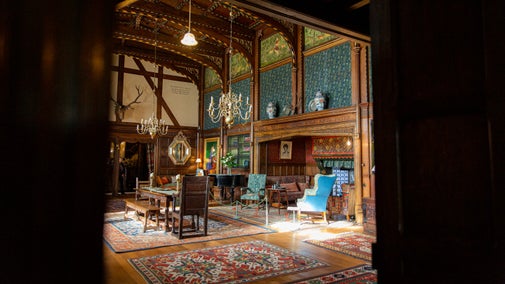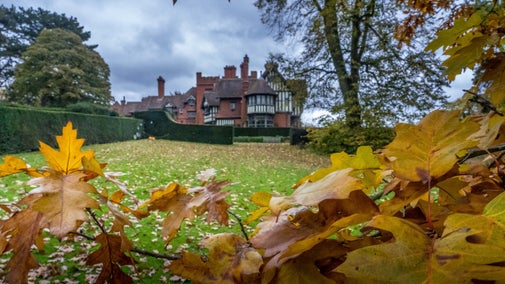
Wightwick's collections
Explore the objects and works of art we care for at Wightwick Manor on the National Trust Collections website.

The story of the Mander Brothers mirrors the rise and fall of many of Britain's great manufacturing companies. But it also reveals the business acumen which funded Wightwick and its collections as well as the social care which is synonymous with the Mander name.
The Company traces its beginnings back to 1773 when John Mander started chemical manufacturing producing pigments used in the production of paints and lacquers.
His nephew Charles went into manufacturing varnish and was in turn followed by his two sons, Charles Benjamin and Samuel Small.
These were the eponymous ‘Mander Brothers’ who in 1845 started to manufacture varnishes in St John Street, where they lived right in the centre of Wolverhampton.
The company expanded on the site and started the production of paints in 1865 followed by printing inks in 1882.
These, and the paints and varnish, were exported all over the world making them one of the largest manufacturers of the products worldwide.
From 1879 the company was run by their respective sons, Charles Tertius (the owner of The Mount) and Samuel Theodore (builder of Wightwick Manor).
The firm continued to expand such that by 1906 they needed larger premises and purchased the Wednesfield Works and the Townwell Works.
The company took the welfare of their employees very seriously and in the 1920s and early 1930s pioneered a Works Council, Contributory Pension Schemes for both workers and staff, a 40-hour week (in 1932 - the first arrangement for workers in the country), a sickness benefit scheme as well as providing sports facilities and an in house magazine called The Green Can.
The company supported whole families and often recruited on family ties to current workers. During the Second World War copies of the Green Can were sent to serving employees abroad so they could keep in touch with what was happen back home.
In 1924 the partnership of 1845 was altered to a limited company, of which Geoffrey Mander was the Managing Director, and all the directors were family members.
Later, in 1937, it was again changed to Mander (Holdings) Ltd, when it merged its printing inks division with John Kidd & Co. and split the company into Paint, Varnish, Printing Ink and Property Divisions.
In the period between the two world wars, they survived mainly due to their overseas markets and to further expand they purchased another factory in Heath Town in 1926, which enabled them to move paint and ink production from the city centre factories.
One of the factors which maintained their success was their research department which was one of the best in the industry. Their main strategy was the development of printing inks and this continued at the company's centres of excellence until its final take over.
As a part of the growth of the company, it took over paint and printing ink manufacturers and reconstituted itself into four divisions, industrial paints, domestic paints, printing Inks and property.
The latter division decided to develop the original factory site in the centre of Wolverhampton in 1964 and built the Mander Shopping Centre, together with an office block.
Geoffrey Mander moved from MD to Chairman of the overall holding company in 1951 where he remained up until his death in 1962 when he was succeeded by Philip Fitzgerald Mander, the last member of the family to hold a board seat.
After this, although many of the shares were held by the family, no family member joined the Board, and the company was run by various recruited directors.
In 1973 they took over British Dolomac Ltd. and in the late 1980s Premier Inks, Q C Colours and Johnson & Bloy, to increase its manufacturing and marketing capacity.
This was followed in 1991 by the takeover of Windeck Ltd. At the same time the Company was restructured and became Manders plc.
In 1992 they were subjected to a takeover bid themselves, which although unsuccessful, precipitated a rethink about where the Company was going.
Printing ink was seen as the way forward and in 1993, the Industrial Paints Division was sold to Croda International and it bought Croda's Ink Division.
This was followed in 1994 by the takeover of Morrisons Inks and Premier Inks and then in 1996, Klinten.
These purchases were funded in the main by the sales in 1994 of the Decorative Paints Division to the Total Group and The Mander Centre to The Prudential Insurance Co.
The company was now the foremost producer of printing inks in Europe with worldwide sales and manufacturing facilities.
In 1997, it became the subject of a successful takeover bid itself from The Flint Ink Corporation of America, a family run business which has gone on to be the third biggest manufacturer of printing inks in the world.

Explore the objects and works of art we care for at Wightwick Manor on the National Trust Collections website.
Explore a home full of Pre-Raphaelite art and William Morris interiors, lovingly collected by Sir Geoffrey and Rosalie, Lady Mander.

Visit the De Morgan Gallery, a partnership with the De Morgan Foundation. ‘Look Beneath the Lustre’ looks at how Evelyn and William De Morgan were inspired to create art.

The garden at Wightwick is the perfect place for a walk after enjoying the delights of the house. Designed by Thomas Mawson, today it has something to see no matter what the season.

Meet the original influencers; the romantic rulebreakers working in the mid to late 1800s and the effect their work and ideas had on the Manders’ décor choices at Wightwick.

Learn about people from the past, discover remarkable works of art and brush up on your knowledge of architecture and gardens.

From landscape gardeners to LGBTQ+ campaigners and suffragettes to famous writers, many people have had their impact on the places we care for. Discover their stories and the lasting legacies they’ve left behind.
